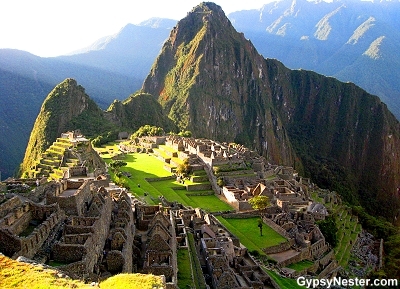
When we stepped off the Expedition Train at Aguas Calientes we wasted no time, proceeding directly to the busses for the ride up to Machu Picchu.
We did not stop to eat, did not check into our hotel, did not pass go, and did not collect two hundred dollars.
We just climbed aboard our carriage for the harrowing trip up the side of a crazy-sheer cliff.
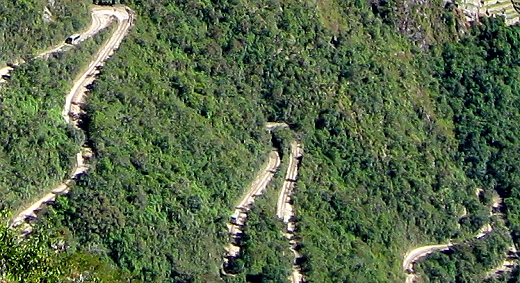

The road takes thirteen switchbacks to make it up the mountain, all while passing busses coming down hill on this somewhat-less-than-two-lane dirt road.
Several times we were clinging right on the edge… with no guard rails… not that they would stop a bus from going over the side.
But hey, they would’ve made us feel better.
However, as soon as we rounded the last switchback and saw the ruins spread out before us, all of that was forgotten.
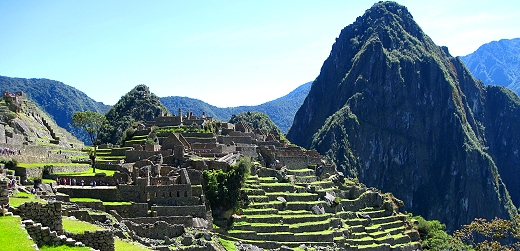

Our super-guide Eddy would take us through the entire site, but first lunch and some delicious Goldfish Ceviche… we had no idea, hopefully a translation snafu and not actually the bowl-inhabiting pet.
Crazy name aside, it was tasty.
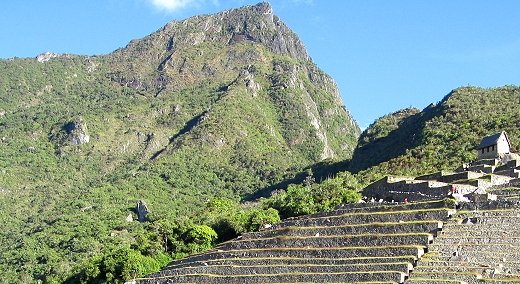
Over our Goldfish, Eddy explained that Machu Picchu is not really the name for the city – that name is lost forever. When Hiram Bingham came here in 1911, the locals told him of a place between Machu Picchu (old mountain) and Huayna Picchu (young mountain).
When Bingham told the world of his “discovery,” (how does one discover something that lots of people already knew about?) the name stuck.
Click here to learn how we dealt with altitude issues while in Peru
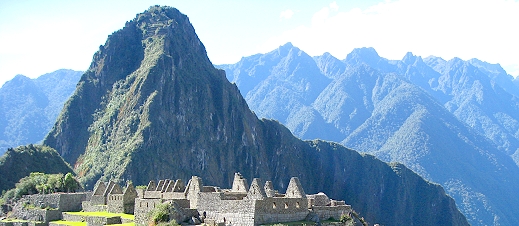
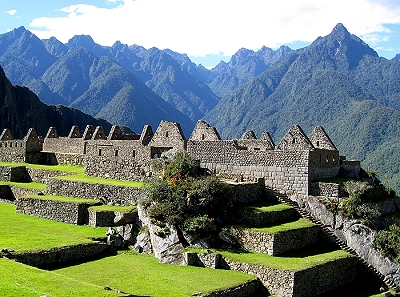
Our tour began with Eddy showing us the very different styles of stone work, which implies that the building of Machu Picchu took place over several different times.
This goes against many of the guidebooks that claim the entire city was built, occupied, and abandoned within the span of about one hundred years.
Eddy most certainly doesn’t buy that theory, but as with so much about the Empire of the Incas, the facts remain unknown.
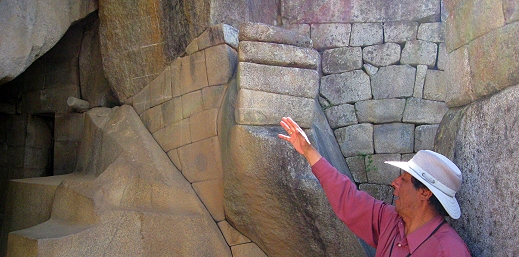
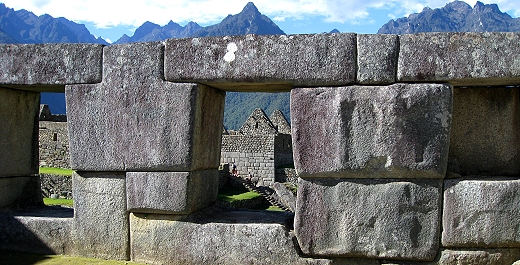
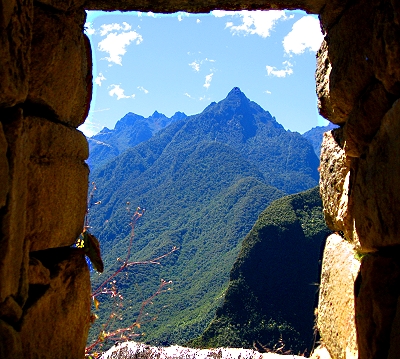
Another place where Eddy diverged from the books was when he said how he feels it is not the ruins themselves that are so mind blowing, but the location.
At first that sounded strange, but as we looked throughout the sight we had to agree.
Not to discount the remarkable structures and work involved, just to acknowledge that this spot is truly amazing above and beyond the ruins.
Click here to see our entire adventure through Peru!
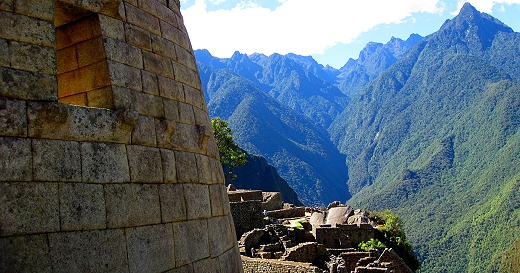
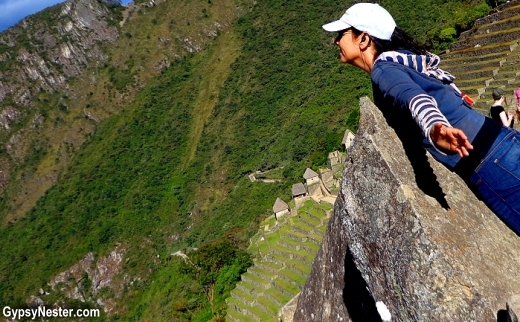
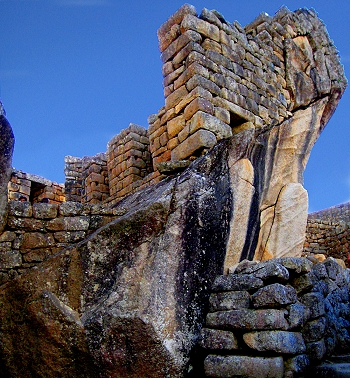
Theories abound as to the purpose of Machu Picchu… summer home for the Inca, agricultural testing site, hideout, fortress, or sacred city, but no single explanation seems to fit.
Perhaps the truth is some combination of these that will forever remain a mystery.
Click here to learn how we dealt with altitude issues while in Peru
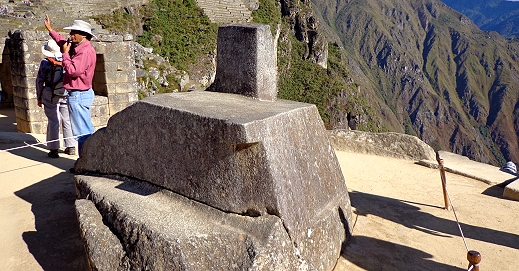
We moved on through the ruins and came upon a diamond shaped rock that was cut and placed to depict and align with The Southern Cross, then another incredibly carved boulder that is orientated with the sun called Intihuatana.
In the Quechua language inti means sun and watana (huatana in Spanish) means place to tie up, so this is often called the hitching post for the sun.
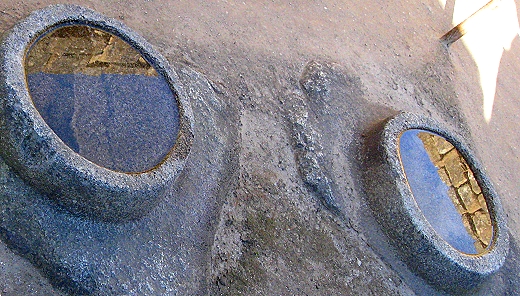
Next we entered a small building containing two carved stone pools that perfectly reflect the sky through a window, but only when the viewer is standing on the small rocks that mark the proper spot.
It is believed that these were used for star gazing… perhaps an Inca version of late night TV.
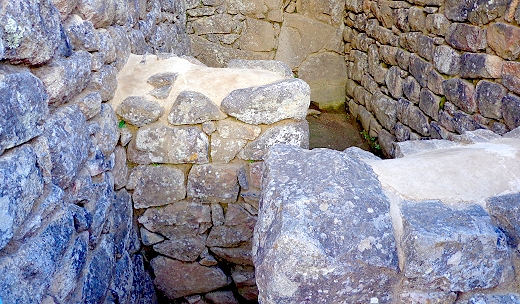
In one tiny entrance we noticed a strange doorway. A wall blocks direct access, forming a kind of S turn to get inside, so we asked Eddy about it.
He said this was a storage room and the extra wall was to keep the llamas out of the food supply. It seems that they can’t manage the tight turns, ingenious.

Speaking of llamas, these cousins of the camel pretty much have the run of the place.
The nimble buggers are everywhere, hiking side-by-side with visitors, stubbornly blocking paths and standing around looking pensive.
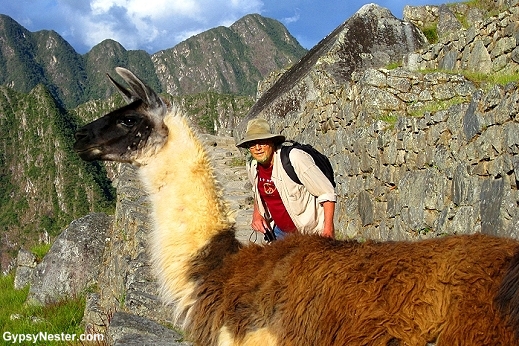
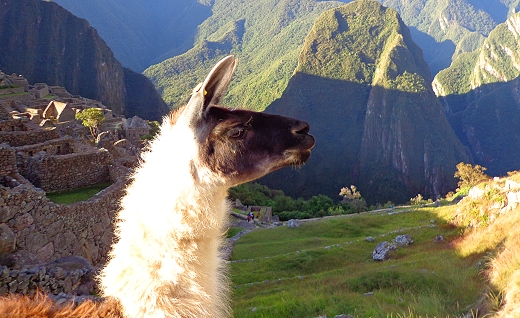
See more great photos of the pensive llamas of Machu Picchu!
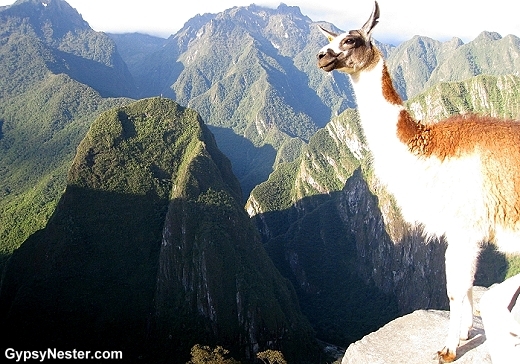

When the site closed at five, we headed back down the crazy road to find our hotel and some food.
We checked into the very European feeling Hotel El Mapi, and toasted the day with a Pisco Sour.
Pisco is a distilled grape type of brandy and is considered the national drink of Peru.
Since we sampled the quintessential Peruvian drink, we figured we should set out in search of some cuy for dinner.
Cuy is guinea pig – yes just like the pets – and is traditionally eaten in the Andes highlands on special occasions. We decided an occasion couldn’t get much more special than celebrating our visit to Machu Picchu, so when we saw a place with cuy al horno (oven roasted guinea pig) on the menu, we sat right down.

The cuy came baked and quartered on a plate, head and all, with some potatoes on the side. Most disturbing were the tiny little feet and the two buck teeth. But we’d come this far, so we had to eat it.
Like the old cliché… it tasted like chicken. Only this time it was true. Like a chicken thigh, or closer to rabbit. It’s good, and yes, we ate the whole thing, which was really only a few forkfuls. Between the cuy dinner and the goldfish at lunch, we took to calling this the day we ate pets.

In keeping with the celebratory spirit of the occasion, we made plans for the next day’s return to Machu Picchu to visit the Temple of the Sun.
Two windows in the temple are aligned so that on each of the solstices the sun rises directly through them. Since we were less than a week away from the June solstice (winter here, summer in the northern hemisphere), we figured that alignment should be pretty darn close.
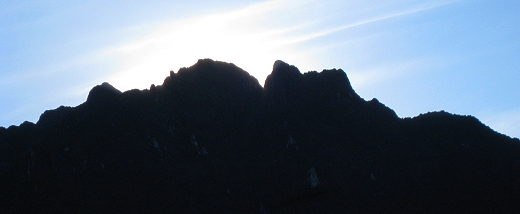
Just before daylight we once again made our way to the busses. Several sources mentioned long lines for the first bus to go up each morning, but once again Eddy steered us in the right direction and advised us to get to the bus just before 6am. At 5:55 we walked right on to the second bus.
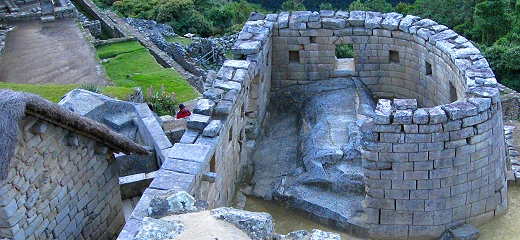
With daylight breaking we scurried toward the temple, which stands in the center of the ruins, and found a spot where we could watch the sun come through the window.
Sunrise! The cosmic alignment was pretty darn close and the window lit up as advertised. We, and everyone around us, were feeling very in tune with the cosmos.
Click here to see our entire adventure through Peru!

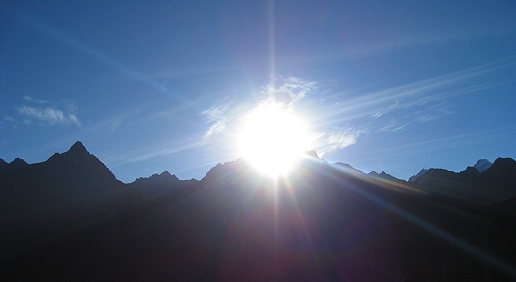
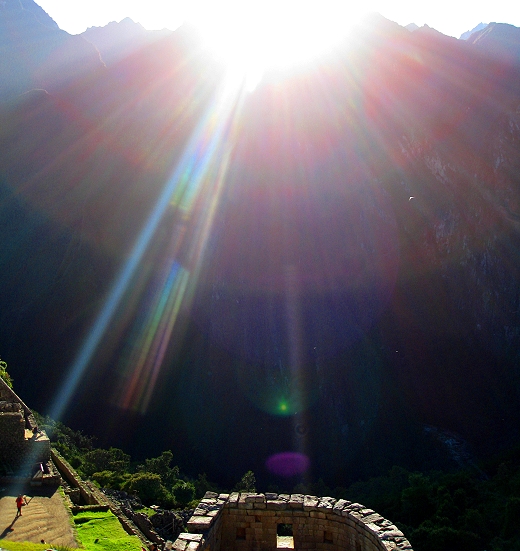

From the temple we climbed upward to the top of the ridge between the two peaks, Machu and Huayna Picchu, to get our first view of the back side of the ruins.
We were surprised by how much was back there. About half as big as the front side, but concentrated more on the terraces that were used for farming and, perhaps more important in this case, preventing erosion and landslides.
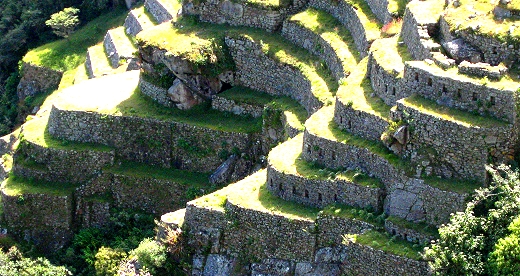
This was also where we could catch the famous Inca Trail. The trail runs for some fifty miles all the way to Cusco, and is a remnant from the expansive system of roads or trails that spanned Tawantinsuyu, the Quechua name for the Inca Empire.
But we would only be going a couple of those miles, up to the Sun Gate, or Inti Punku in the Quechua language.
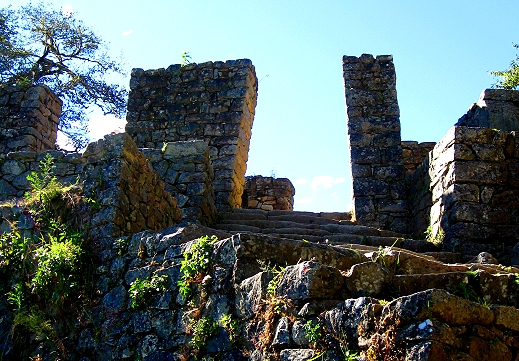
Click here to learn how we dealt with altitude issues while in Peru
In about an hour we climbed up another few hundred feet above sea level from the main part of Machu Picchu, taking us over 2,000 feet above the valley below. Inti Punku is the spot where the sunrise can be seen through the Sun Temple window on the solstice in December.
It is also where hikers that have walked four days along the Inca Trail from the Sacred Valley get their first view of Machu Picchu.
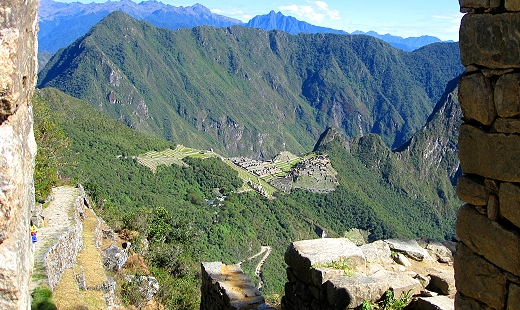
For the rest of the day we simply soaked it all in, until we needed to make our way back so we wouldn’t miss our train.
Missing the train would be a problem since it was our only way out of Aguas Calientes… unless we wanted to hoof it back to Ollanaytambo.
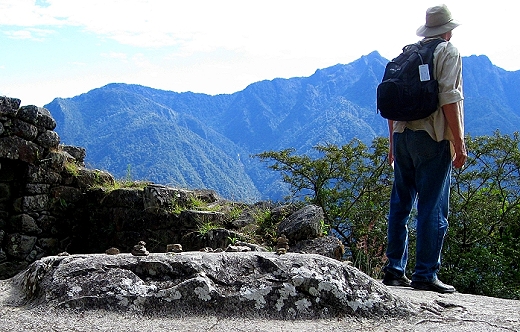
David & Veronica, GypsyNester.com
Click here to see our full adventure with Road Scholar – a not-for-profit organization – through Ecuador, Peru, The Galapagos Islands, Machu Picchu and much, much more!



Hey! Your article was a nice read, it reminded me of my visit to Machu Picchu. I was there last year and bwt, the road is now paved and I believe the bus ride is safer? My husband and I decided to climb the many many stairs until reaching the entry gates of the city.
And btw, I do agree with you and your side question about Hiram Bingham “discovering” the city that people already knew about. Here in Cusco we always used to say that he “discovered it to the modern world” because for the locals it was no secret 🙂
Love the pictures, very details and …not to mention the llama. Is is just me or is it the same brown llama that lives at Machu Picchu that appears in all touristy pictures? Hahaha
Thanks for the info. Seems like the llamas have the run of the place.
The pictures look amazing, would love to go check out Machu Picchu in the near future.
These lost cities tell us a lot about our ancestors how they live and infrastructure and all other things. You had a great collection of pictures. Thanks mate for this amazing info, really appreciate.
Fabulous pictures. I’d love to go. The tour is offered from the Princess cruise we’re on but we’ve decided not to do it this time. Dave trekked there back in the day and loved it.
Thanks Jo! Definitely worth putting on the list.
This post brought back great memories of our month in Peru…of Machu Picchu and of lamas.
We hiked up the mountain to Machu Picchu… It was very intense, long, endless but well worth it.
You actually ate the guinea pig? Way braver than me….
Peta
Well you hiked the Inca trail, so much braver than us. Guess that makes us even. 😉
Absolute beauty! Our friend visited last year and love it. We are going to have to add it to our travel list!
Yes, you definitely should. We’d say it should be on everybody’s list.
I love that photograph of the llama looking out over the cliff. The expression is priceless!
These are by far the best photos I’ve ever seen of Machu Picchu. Don’t think I could brave that bus ride, though – so thanks for the vicarious views! Food looks excellent, too. I think that your ‘goldfish’ or dorado is what’s called dolphin fish and mahi mahi elsewhere…
Thanks. Yes, not the bowl swimmers. 😉
Definitly have put this place on my bucket list. Marvelous, and well told stories!
Thanks for sharing this post! You’ll have to do wayna picchu “next time”, it’s also an incredible view of the ruins! But a crazy vertical hike/climb too. When we were there my mom saw llamas stampede a group of tourists, and said that it was literally the funniest thing she has ever witnessed. I think it’s really cool that you guys went two days in a row, so you really got to see everything!
We could see people up there and that looked just a little too crazy for us. Highly recommend taking two days if at all possible.
Thank you so much for these wonderful photos and the data you wrote about. I was lucky enough to visit Machu Picchu twice during the 1990’s. I still think of it today and consult my old photos as time allows.
The traveling bug has been biting me again so March 27 I left my home in SW Florida and I am back in South China for a year or so.
Good luck to you both – and always be careful… as will I….David
Thanks David. We finally made it China this year. Take care.
Amazing place! I could never eat the guinea pig…having had them as pets…well, am a vegetarian now, anyways. I agree with your guide. I think it is the location that makes it special. Love the wandering llamas! Thanks for sharing your adventures. 🙂
As always, it’s our pleasure to share.
Love the pictures! My favorite part of Macchu Picchu was the hike up Wayna Picchu. Did you guys end up doing this?
We also had the cuy–wasnt crazy about it….
Didn’t make it up Wayna Piccu, we chose the Sun Gate instead. Cuy was OK but wouldn’t have it every day.
Living vicariously here! I’m SO very glad you took the trip (I voted for this one)! Amazing (well, except the pets part – you are definitely more adventurous in that area than I think I’d be).
We finally reframed two of our favorite blown up Machu Picchu photos from our 1982 honeymoon and have them hanging over the sofa in our New Jersey beach house. It couldn’t be further away except in our memories.
Book recommendation: 1491 by Charles Mann—a journalist recounting the history of the natives of the Americas before Columbus. A large portion
of the book is dedicated to what we now refer to as the Incan Empire.
Write on,
Suzanne
Thanks for the book recommendation, we’ll check it out.
Goldfish AND guineas pigs! Have your friends started hidding their pets when you pop round?
I do hope I make it here one day. Great photos by the way.
It was strange, but from now on the pets should be safe. 😉 Thanks.
Our trip is coming closer so it is great to re-read your posts. Do you remember the name of the restaurants you ate at in Peru? Also did they have anything besides cuy where you ate? Not sure we are as adventurous as you guys. It looks like you just put on a sweatshirt and long pants. Warm enough in the mountains? Please e-mail me directly if you choose. Looking forward to reading more.
Rosalie
Warm days cool nights in the mountains. Don’t remember the name of the restaurant but every place has plenty of great options… even for the not so adventurous. 😉